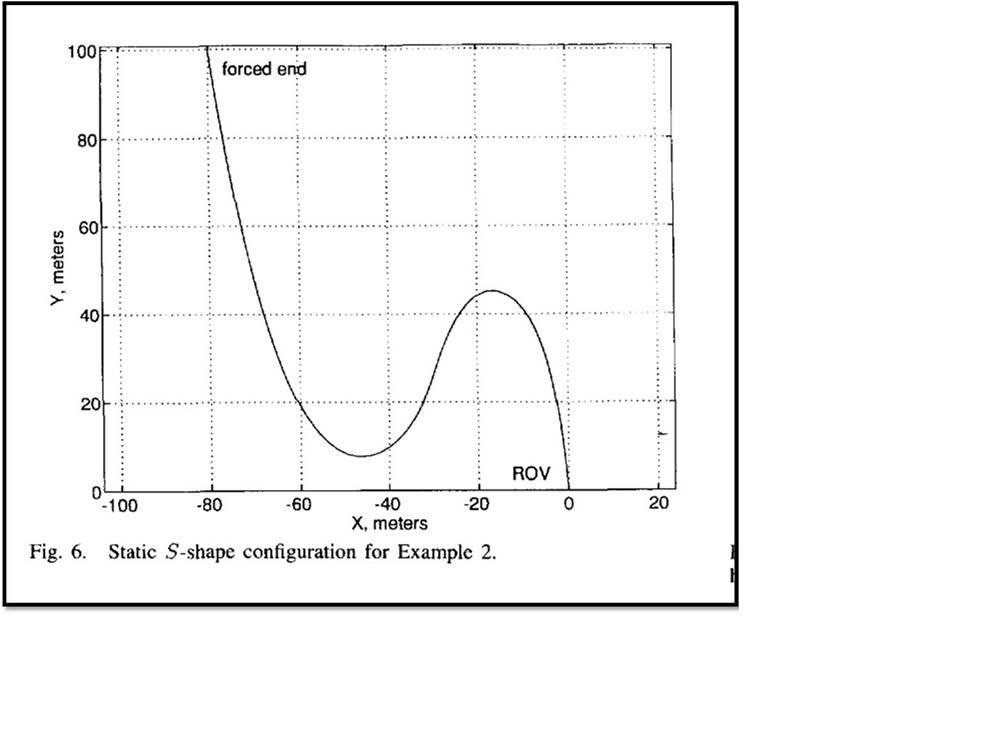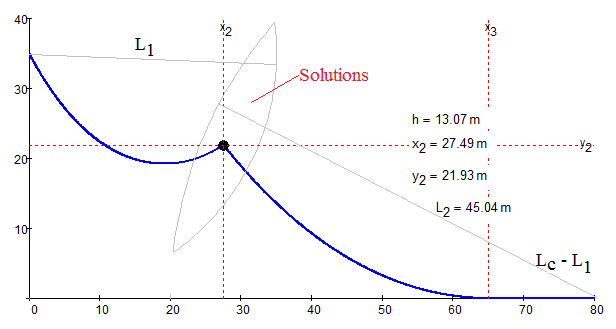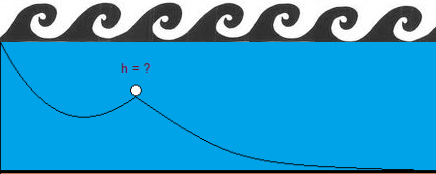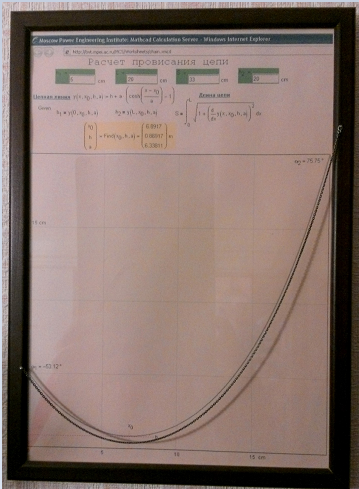Community Tip - You can subscribe to a forum, label or individual post and receive email notifications when someone posts a new topic or reply. Learn more! X
- Subscribe to RSS Feed
- Mark Topic as New
- Mark Topic as Read
- Float this Topic for Current User
- Bookmark
- Subscribe
- Mute
- Printer Friendly Page
Solve Block Problem - "S" Shaped Catenary
- Mark as New
- Bookmark
- Subscribe
- Mute
- Subscribe to RSS Feed
- Permalink
- Notify Moderator
Solve Block Problem - "S" Shaped Catenary
I have a boat which is supporting an umbilical (cable) - which is supplying the electrical power and communications to an ROV (remote operated vehicle) which is several hundred metres below the surface of the water. There is a bit of a twist to the problem - because the ROV operator wants to attach weights to the umbilical (at location number A - over maybe 50m of umbilical length) - and he also wants to add small buoyancy modules (at location number B - over maybe 50m of umbilical length). The ROV operator wants to do this - in order to isolate the ships motion from the ROV - so the shape of the umbilical will be an "S" shape (rotated through 90 degrees) - when looked on side ways.
I decided to approach this problem as a "chain" - with a series of links (with each link having its own individual weight to allow for the situation where the umbilical has additional weight - location A (lead weights) - or buoyancy blocks - at location B). I then sought to get equilibrium at each end of each link. I then set out the equations for 16 links - and used the Find function to solve for the 50 unknowns. The equations are non linear as they have sin and cos functions - so using the Find function appeared the only option. So apart from the spreadsheet being - not very slick - I noticed that if I had more than 16 elements - which generated 50 unknowns - the Find function would not work with more than 50 unknowns.
As you can perhaps appreciate - if the umbilical is 2000m long - dividing this up into 16 links - is very rough indeed. Additionally, I would like to input the drag forces on the umbilical - but that is just going to add more unknowns - as this varies with the inclination of each link.
So I am looking for any ideas on how I could
- add more links to get a more "accurate" representation of the "S" shape (rotated through 90 degrees) - when looked on side ways
- how to resolve the 50 unknown apparent limit on the Find function
Many thanks in advance - to positive contributors.

Solved! Go to Solution.
- Labels:
-
Other
- Mark as New
- Bookmark
- Subscribe
- Mute
- Subscribe to RSS Feed
- Permalink
- Notify Moderator
I do not see it. Share us a solution please![]()
- Mark as New
- Bookmark
- Subscribe
- Mute
- Subscribe to RSS Feed
- Permalink
- Notify Moderator
Jan Kowalski wrote:
I do not see it. Share us a solution please
See please http://communities.ptc.com/videos/3787 and the attach.
- Mark as New
- Bookmark
- Subscribe
- Mute
- Subscribe to RSS Feed
- Permalink
- Notify Moderator
Thanks Valery for sharing![]()
Walery you say: "We solve numerically (see the vibrations of the chain) "
the cause of the vibration is bad chosen calculation method.
- Nonlinear: Levenberg-Marquardt ->bad (bug)

- Nonlinear: Conjugate Gradient -> good -"Advanced option I'm change to(Variable estimation to quadratic)" -> more time to calculate

- Nonlinear: Quasi-Newton -> a little better (bug)

Perhaps it is the fault of the software bug![]()
I'm calculated the integral of the equation and abandoned see worksheet. I'm added video symulation NO vibration.
- Mark as New
- Bookmark
- Subscribe
- Mute
- Subscribe to RSS Feed
- Permalink
- Notify Moderator
Just in your file Chain-0-1-2-3-4.xmcd.zip just change the Nonlinear: Conjugate Gradient and TOL=10^-12 and work fine.![]()
- Mark as New
- Bookmark
- Subscribe
- Mute
- Subscribe to RSS Feed
- Permalink
- Notify Moderator
Sorry, this system has infinite number of solutions - between two curves on the plot. The task will have one solution if we will take into account not only the kinetics but also the dynamics, forces. And Levenberg-Marquardt method (with vibration) is best, more honest ![]()

- Mark as New
- Bookmark
- Subscribe
- Mute
- Subscribe to RSS Feed
- Permalink
- Notify Moderator
I'm sorry but I do not agree with you. Vibrations to be only when the sea were waves. Pontoon to float along with the waves. But in this case it is not possible. Let this case check the other a professor of physics.
- Mark as New
- Bookmark
- Subscribe
- Mute
- Subscribe to RSS Feed
- Permalink
- Notify Moderator
Yes! Waves!

- Mark as New
- Bookmark
- Subscribe
- Mute
- Subscribe to RSS Feed
- Permalink
- Notify Moderator
Gordon Durward wrote:
Hi Valery,
Thanks for your recent posts - and the efforts of your students to solve the problem - and yes I can see it is even more challenging for them - because their number system is different in Burma.
Gordon.
Gordon, sorry, I understand your irony, but without experiments (in one pool with moving water and with my students ![]() ), your problem can not be solved. I think.
), your problem can not be solved. I think.
- Mark as New
- Bookmark
- Subscribe
- Mute
- Subscribe to RSS Feed
- Permalink
- Notify Moderator
Hi Valery,
Sorry, but I have been off the internet with a virus on my computer - which I have now got fixed - so sorry for not passing comment before now.
I have had a look at your mathcad spreadsheet with your flotation buoy - and I have to say the obvious - which is that you haven't set up equations to deal with the weight of the cable - or the force coming from the flotation buoy. As I am sure you will appreciate it is these forces that will determine the shape of the catenary. So with my engineering hat on - I am sorry but what you have produced is not much use in the real world - since as I have said the whole problem is driven by forces. (I do appreciate your effort though).
However, in addition to the above - what you have come up with - still does not resolve the problem that I posted originally.
However, I have read your final comment - in which you say - "your problem can not be solved - I think". If this is your conclusion - then should PTC not improve Mathcad - with technical enhancements - rather than just giving it a new interface - like you have with Mathcad Prime? I am an engineer - and I want to use Mathcad to solve "real world problems" (like the one I posted originally) - and I sense PTC are not moving Mathcad in that direction - instead they are still selling Roark's formulas (which are useful - but FEA has largely superceded this) - so isn't it time PTC spoke to engineers - and find out what they want Mathcad to do?
I just thought I would say this - since there might be some other PTC software developers who might read this - since I have noted that more than 800 people have viewed this discussion so far.
Anyway - appreciate your efforts.
Gordon.
- Mark as New
- Bookmark
- Subscribe
- Mute
- Subscribe to RSS Feed
- Permalink
- Notify Moderator
Valery Ochkov wrote:
Valery Ochkov wrote:
I will give to my students tomorrow this problem:
/servlet/JiveServlet/downloadImage/2-198103-46008/2cetenary.png
The first step of my students:
We have checked how Mathcad accurately calculate ![]()
- Mark as New
- Bookmark
- Subscribe
- Mute
- Subscribe to RSS Feed
- Permalink
- Notify Moderator
This may be useful:
http://sci.tech-archive.net/Archive/sci.math/2007-02/msg02379.html
for demonstration:
http://stackoverflow.com/questions/10872464/catenary-with-manipulate
I'm made symulation with Blender 2.66. Catenery with chain trough to tree point.The third point is on the moving.
- Mark as New
- Bookmark
- Subscribe
- Mute
- Subscribe to RSS Feed
- Permalink
- Notify Moderator
The problem is in contraction!
I hope tomorrow we can see the solution with animation.And we can check the solution by help with real catenary! How!?
I like to collect a wall pictures with mathematical meaning.
One of them is so - a virtual and real catenary. It is a print of this Web-Sheet - http://twt.mpei.ac.ru/MCS/Worksheets/chain-eng.xmcd
with real silver catenary

- Mark as New
- Bookmark
- Subscribe
- Mute
- Subscribe to RSS Feed
- Permalink
- Notify Moderator
- Mark as New
- Bookmark
- Subscribe
- Mute
- Subscribe to RSS Feed
- Permalink
- Notify Moderator
Sorry, no video no sound. I cannot see it without extra tools.
Why do you not use standard tools of PlanetPTC for video creating
- Mark as New
- Bookmark
- Subscribe
- Mute
- Subscribe to RSS Feed
- Permalink
- Notify Moderator
Of course, I have no problem with playing the video file, use VLC ,Media Player Classic Home Cinema or what else.You cannot see use this page:
- Mark as New
- Bookmark
- Subscribe
- Mute
- Subscribe to RSS Feed
- Permalink
- Notify Moderator
Thanks, I (We all!) can see this video http://communities.ptc.com/videos/3773
- Mark as New
- Bookmark
- Subscribe
- Mute
- Subscribe to RSS Feed
- Permalink
- Notify Moderator
Attached video works perfect here with a variety of players. Much preferred over those crappy flash files in the PTC video section.
Having both makes all of us happy, I guess 😉
- Mark as New
- Bookmark
- Subscribe
- Mute
- Subscribe to RSS Feed
- Permalink
- Notify Moderator
- Mark as New
- Bookmark
- Subscribe
- Mute
- Subscribe to RSS Feed
- Permalink
- Notify Moderator
Richard Jackson wrote:
See the attached worksheet.
It will be not bad to see one plot!
- Mark as New
- Bookmark
- Subscribe
- Mute
- Subscribe to RSS Feed
- Permalink
- Notify Moderator
Richard Jackson wrote:
See the attached worksheet.
Looked through the file and it all is a little improved , work fine to me![]()
- Mark as New
- Bookmark
- Subscribe
- Mute
- Subscribe to RSS Feed
- Permalink
- Notify Moderator
You got it to work for one equation, but actually it cannot work for all the variables. There are more then 50 of them, and that is not allowed. The solution vector on the right has fewer values then the number of variables being solved for, and is therefore incomplete. The vector of variable names on the left also has fewer elements than the number of solve variables, which is probably the source of the "pattern error" when the evaluation on the right is deleted.
There were some mistakes in my previous worksheet. I threw it together in a real hurry, and didn't even look at the results. The angles of the segments are not realistic. Here's a new version with the mistakes fixed. The solve block needs to have the angles constrained to get a realistic answer. I also added a function to plot the catenary, which makes it easier to check the solution is realistic (so you have your plot Valery ![]() ). New stuff is highlighted in cyan.
). New stuff is highlighted in cyan.
- Mark as New
- Bookmark
- Subscribe
- Mute
- Subscribe to RSS Feed
- Permalink
- Notify Moderator
I just realized there's a better approach. New stuff highlighted in green.
Note: Worksheet edited 8:30 pm EST.
- Mark as New
- Bookmark
- Subscribe
- Mute
- Subscribe to RSS Feed
- Permalink
- Notify Moderator
Sorry, Now I see plots...
The second step - from a lot of variables to sets of vectors...
- Mark as New
- Bookmark
- Subscribe
- Mute
- Subscribe to RSS Feed
- Permalink
- Notify Moderator
Looked through the file and it all is a little improved , work fine to me.![]()
The FIND function should be the same variables as vertical an horizontal vector.And it has just a mistake.
Sorry English bad![]()
- Mark as New
- Bookmark
- Subscribe
- Mute
- Subscribe to RSS Feed
- Permalink
- Notify Moderator
I'm surprised you took te time to type in the extra variable names. Since that version of the solve block wasn't very useful I couldn't be bothered ![]() I guess more than 50 variables are allowed.
I guess more than 50 variables are allowed.
Looks can be deceptive. The solution is not realistic (the solve block needs the same constraints I added).
It's generally not a good idea to set TOL and CTOL to very small numbers. The floating point precision is only about 10^-15, so if you set them this low (setting them lower than the precision is the same as setting them at the precision) all sorts of things start to fail, including Find, numerical integration and differentiation, etc. If you get rid of those settings you can put Find back instead of minerr, and it will give you the same answers.
- Mark as New
- Bookmark
- Subscribe
- Mute
- Subscribe to RSS Feed
- Permalink
- Notify Moderator
Hi Ricahard,
I would just like to say thank you for all the effort you have put into showing me how to solve this problem using vectors - which is a method I haven't seen before in the solution of multiple unknowns - and I have been on the Mathcad courses and it wasn't discussed in those courses - and I bought a book on Mathcad - and it was not in that either. It is definetely the way to solve this type of problem - it is a very good way of doing it.
I am sure that there are other engineers out there - like me - who just want to solve lots of equations with lots of unknowns - and I feel it would be good if Mathcad could maybe have some "real world examples" in its "database" of what Mathcad can do - then I am sure others like me would learn from these examples.
Many thanks for sharing you knowledge of Mathcad with me and all those other people following this problem I posted a few weeks ago.
Gordon.
- Mark as New
- Bookmark
- Subscribe
- Mute
- Subscribe to RSS Feed
- Permalink
- Notify Moderator
I would just like to say thank you for all the effort you have put into showing me how to solve this problem using vectors - which is a method I haven't seen before in the solution of multiple unknowns - and I have been on the Mathcad courses and it wasn't discussed in those courses - and I bought a book on Mathcad - and it was not in that either. It is definetely the way to solve this type of problem - it is a very good way of doing it.
Apart from being easily extensible to more variables, it saves typing out dozens of variable names at every step. Since I'm lazy that's a big plus for me ![]()
There is a lot you can do in Mathcad, and books and courses can only cover so much. If in doubt, the best thing to do is exactly what you did: ask here.
I feel it would be good if Mathcad could maybe have some "real world examples" in its "database" of what Mathcad can do - then I am sure others like me would learn from these examples.
There are many examples on these forums. Also look here at the old Mathsoft library:
http://web.archive.org/web/20040804121505/http://www.mathcad.com/Library/
I am sure that there are other engineers out there - like me - who just want to solve lots of equations with lots of unknowns
Bear in mind that with a very large number of variables it might become unstable. You are trying to find the minimum of a very complicated multi-dimensional error surface, and how easy that will be depends on the shape of that surface.
Also, the time taken will scale as the square of the number of variables, so it may become impractical beyond a certain number. In this case you can avoid this problem by using the recursive method I added to the final version of the worksheet. The time taken for that will scale linearly with the number of variables.
- Mark as New
- Bookmark
- Subscribe
- Mute
- Subscribe to RSS Feed
- Permalink
- Notify Moderator
Richard Jackson wrote:
I feel it would be good if Mathcad could maybe have some "real world examples" in its "database" of what Mathcad can do - then I am sure others like me would learn from these examples.
There are many examples on these forums. Also look here at the old Mathsoft library:
http://web.archive.org/web/20040804121505/http://www.mathcad.com/Library/ ...
Also some examples can be found at PTC's "Mathematical Engineering Resources" page:
http://www.ptc.com/appserver/search/mathcad.jsp
http://www.ptc.com/appserver/search/mathcad.jsp?&mod=ptccontenttype::Worksheets
- Mark as New
- Bookmark
- Subscribe
- Mute
- Subscribe to RSS Feed
- Permalink
- Notify Moderator
Result in Mathematica is the same in Mathcad.
Mathematica file attach:
- Mark as New
- Bookmark
- Subscribe
- Mute
- Subscribe to RSS Feed
- Permalink
- Notify Moderator
I don't have Mathematica, so I can't look at it, but it's nice to know the answers are the same ![]()
- « Previous
-
- 1
- 2
- Next »






